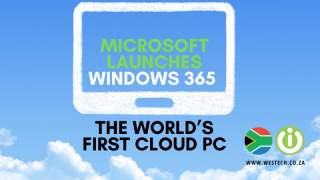Confused About The Launch Of Windows 11 and Windows 365?
Towards the end of June, Microsoft announced the launch of Windows 11 and, shortly after that, Windows 365. If you are feeling a little confused about two then you are not alone. The following is a simple breakdown to clarify the differences between Windows 11 and Windows 365.
What is Windows 11?
Although Windows 10 was supposed to be the last version of Windows, Windows 11 has superseded it and provides top-notch security and performance capabilities. In addition, its operating system (OS) is designed for modern hardware, so you will be able to use it as long as your PC is Intel 8th generation or newer. Support for this OS will be at least until 2031.
Most of the OS changes are visual. This includes a refreshed Start menu, which no longer uses Live Tiles and can now be found at the centre of the screen, as well as new ways to connect to content, news, games, and people.
- Maximises productivity - Access all the apps you need and multi-task with ease with tools like Snap layouts, Desktops, and a new, more intuitive redocking experience.
- Connect in new ways - Connect instantly to people right from your desktop with Microsoft Teams.
- Tailor your content - With Microsoft Edge and many widgets to choose from, you can quickly stay up to date with the news, information, and entertainment.
- Play anytime - Windows 11 takes gaming to a whole new level with graphic capabilities that rival reality.
What is Windows 365?
Windows 365 is a subscription-based service that allows you to operate from what Microsoft calls a “Cloud PC”. A Cloud PC is a virtual machine that uses a remote desktop connection from any device at hand. Windows 365 runs in the Cloud and can be accessed from any device and any location, as long as there is an internet connection. The beauty of it is that storage and RAM capacity remains unaffected since the apps and files don’t run directly off your device, but rather from the Cloud. Currently, this service is only available for enterprise use but can accommodate any number of users.
- Access files from anywhere
- Secure Cloud storage
- Improved communication
- Predictable spend
- Business continuity
- Automatic upgrades
- Centralised collaboration
How do Windows 11 and Windows 365 work together?
For the general consumer, or companies with older hardware, Windows 11 is the default choice at this stage. However, businesses looking to modernise will have two tiers of Windows 365 to choose from, depending on their size.
Windows 365 allows the creation of Cloud PC’s needed to run either Windows 10 or Windows 11. Since you only pay for the hardware configuration you choose to use, this is a highly cost-effective and practical option for businesses where employees have different job requirements. However, as a subscription-based service, Windows 365 cannot be installed and kept indefinitely, but this does however allow for easy upgrades and excellent security.
Westech, a professional IT support company in South Africa, services all major business sectors across the country and provides remote assistance for offshore companies. They understand that the world is unpredictable right now and their flexible solutions provide companies with the latest in IT technology. Call them or visit their website for further information on how they can assist your business to succeed.
Microsoft Launches Windows 365 – The World’s First Cloud PC
Shortly after rolling out Windows 11, Microsoft has introduced Windows 365. This technology aims to make it easier for users to connect to Windows running in the Microsoft Cloud, regardless of what operating system (OS) they use. It does this by taking the OS to the Microsoft Cloud from where the full wonder of Windows can be securely streamed.
What is Windows 365?
To create a fluid experience across several devices, users require a technology that is always available and easy to use. Simply put, Windows 365 acts as a personalised Windows-based PC in the cloud, which can be accessed using any modern web browser from any device and where all apps and content can be streamed from the cloud to the user’s device or devices.
This Software as a Service offering from Microsoft is a new way of experiencing Windows 10, or Windows 11 and users have a choice of “hardware” that ranges from a single-core virtual PC with 2GB of memory and 64GB of storage to an entire workstation with eight cores, 32GB of memory and 512GB of storage.
This is an enterprise-only offering for businesses of all sizes that Microsoft hopes will provide companies with greater flexibility and a secure way to enable their teams to be more agile and productive, irrespective of their location.
Benefits of Windows 365
It has the added benefit of allowing companies to allocate the exact resources to their users based on their individual requirements. This is achieved by allowing the IT department to make changes to the Cloud PC’s specifications and by informing the IT Manager about how well a remote PC is performing via a Resource Performance report. If a user receives a low resource score, the IT department can add more RAM, CPU cores or storage to improve efficiency. This modernisation of Windows means that users will no longer need to worry about an intermittent internet connection or their PC slowing down.
As a cloud-based service, security is the foundation of Windows 365. With cybersecurity threats increasing, the platform has been built on a Zero Trust principle to protect sensitive company information.
Users will be able to work offline and, as 5G rolls out and Wi-Fi 6 becomes more comment, they will be able to use a browser-focused operating system on a terminal without the need for a localised hard drive, as in a thin-client setup.
This approach has the advantage of:
- Lower maintenance costs
- Tighter security protocols more resistant to cyber-attacks
- Faster deployment
- Fewer disruptions and less down-time
- Quick and easy updates
- Ability to work anywhere with an internet connection
- Collaborate more effectively
Costs of Windows 365
Although costs are not yet known, some of the disadvantages may include a dependency on a network connection, higher latency and possibly an annoyance factor due to the critical use of dual-factor authentication for security purposes.
The deployment will involve creating, assigning and managing the remote virtual desk service through Microsoft Endpoint Manager. This task should be handled by either in-house IT departments or outsourced to IT service providers such as Westech.
For further information about Windows 365, contact Westech, a professional IT services company that provides onsite and outsourced technical support.



